Hey there, lovely readers! Chances are you’ve stumbled upon a common hair problem: Lice eggs vs Dandruff. We have all experienced itchiness on our scalp at some point, and we know how annoying it can be. But before you start panicking, let’s take a closer look at what is happening up there.
The first thing that comes to mind is Dandruff, but what if it’s something else? Have you ever heard of lice eggs? While lice eggs and Dandruff might look similar to the eye, they are two very different conditions. It’s essential to know the difference between Lice eggs vs Dandruff and how to treat them properly.
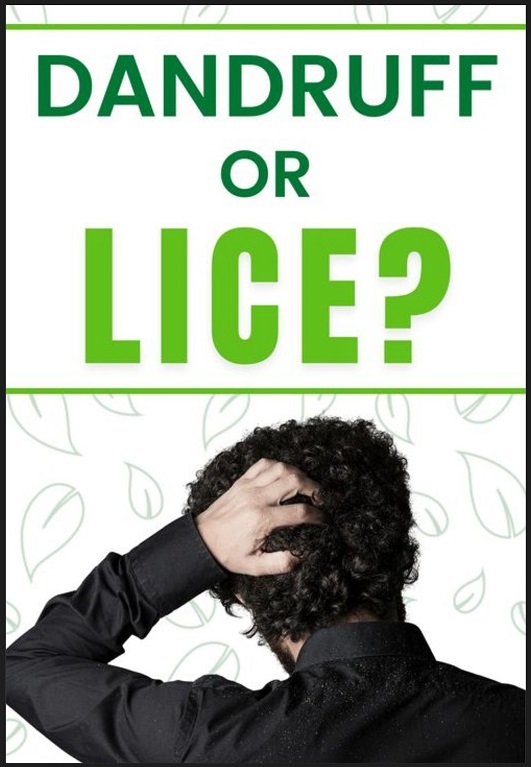
In this blog post, we’ll guide you through the differences between lice eggs vs Dandruff and give you some tips on how to treat each condition. So relax, and let’s get to the root of the problem!
Lice Eggs Vs Dandruff: How To Tell The Difference And Treat Each Condition:
Everyone constantly searches for how to tell the difference between lice and Dandruff. Lice eggs and Dandruff may look similar, but they have distinct differences. Lice eggs are small oval-shaped eggs attached to the hair shaft near the scalp, while Dandruff is an accumulation of dead skin cells that flake away from the scalp.
To tell the difference, you can examine them closely. Lice eggs are tiny and difficult to remove, while Dandruff can be easily brushed away. Lice eggs are caused by an infestation of parasitic insects that live on the scalp, while Dandruff can be caused by dry skin, sensitivity to hair products, or fungal infection.
To treat lice eggs, you must use a lice-killing shampoo and a special comb to remove the eggs from the hair shaft. To treat Dandruff, use a medicated shampoo that contains ingredients like zinc, pyrithione, salicylic acid, or coal tar. It’s also important to avoid using hair products that can irritate the scalp and worsen Dandruff.
Whether you’re facing lice or dandruff, you now possess the necessary information to address these issues effectively. Let’s delve into the signs and symptoms of lice eggs and dandruff individually.
Dandruff – Signs And Symptoms:
Dandruff is a common scalp situation that causes grey or white flakes of dead skin to appear in the hair and on the scalp. Some common signs and symptoms of Dandruff include:
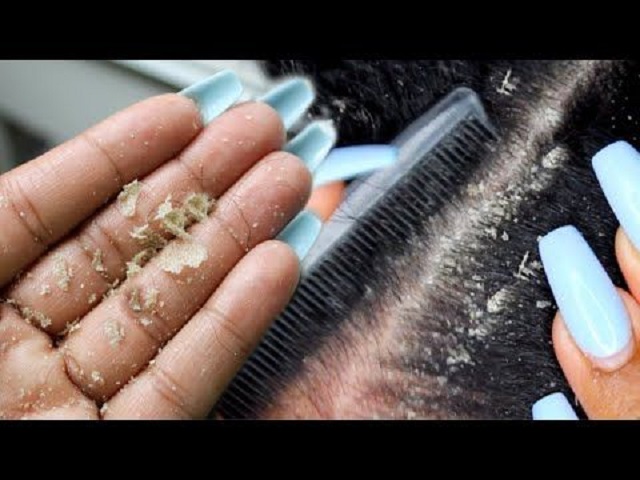
Flakes of dead skin on the scalp and hair:
This is the most common sign of Dandruff. You may notice white or greyish flakes on your scalp and hair.
Flakes of skin on the scalp, hair, eyebrows, beard, or moustache:
This is the most common symptom of Dandruff. Dead skin flakes may be visible on the scalp, hair, and other facial hair (eyebrows, beard, or moustache).
Itchy scalp:
People with Dandruff often experience an itchy scalp. This itchiness can range from mild to severe and sometimes lead to scratching, worsening the condition.
Redness or irritation of the scalp:
Dandruff can cause the scalp to become red and inflamed, which can be uncomfortable.
Oily or dry scalp:
Dandruff can occur in people with either oily or dry scalp types. People with oily scalps may notice greasy-looking flakes, while those with dry ones may have more white flakes.
Scales that may be yellow, greasy, or white:
Dandruff flakes can vary in colour and texture. They may be yellow, smooth, or white and range in size from very small to large.
Hair loss (in severe cases):
In rare cases, severe or chronic Dandruff can lead to hair loss. It is more likely to happen if the Dandruff is left untreated for an extended period.
If you are experiencing any of these symptoms, seeing your doctor or dermatologist is best to help diagnose and treat your condition.
Causes Of Dandruff:
Are you wearied of dealing with an itchy and crusty scalp? Don’t worry; we’ve got your back! Dandruff is a common condition that affects many people, but what are the causes?
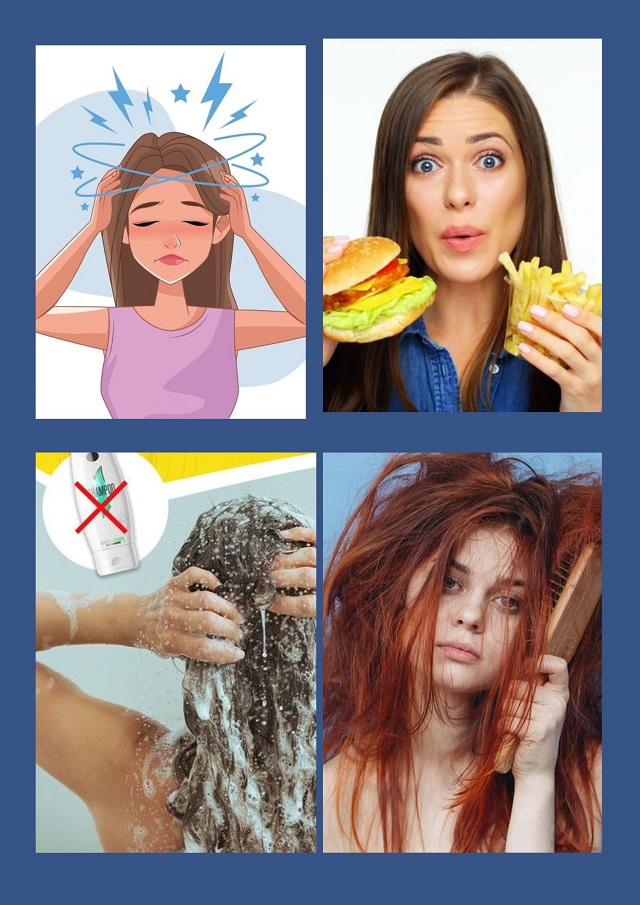
Choosing the Wrong Shampoo:
Yes, it’s true! Using the wrong shampoo that doesn’t suit your scalp type can lead to irritation, itching, and flaking. Ensure you opt for a shampoo suitable for your hair and scalp type to get rid of Dandruff.
Your Body’s Reaction to Stress:
Ah, the stress monster! When under stress, our body releases hormones that can affect the health of our scalp, eventually leading to Dandruff. Ensure you’re taking time out for yourself and indulging in activities that aid relaxation.
Unhealthy Diet:
What you eat matters! Eating a diet high in sugar and processed foods can lead to inflammation in your body, which may result in an itchy and flaky scalp. Intaking a balanced diet rich in vitamins and minerals can go a long way in relieving Dandruff.
Lack of Cleanliness:
The most straightforward solution ever? Keeping your scalp clean! Washing your hair regularly with a gentle shampoo helps remove dirt, impurities, and oil buildup, which can clog your hair follicles and lead to Dandruff.
So, folks, now that you know the causes of Dandruff, ensure to take better care of your scalp and bid farewell to that pesky condition!
Do-It-Yourself Treatment: How To Get Rid of Dandruff At Home:
Dandruff can be a frustrating condition to deal with, but the good news is that you can try many effective home remedies to treat it. You have some Do-It-Yourself Treatments to help you eliminate Dandruff at home. Add these remedies to your hair care routine and say goodbye to Dandruff!
Use Tea Tree Oil:
Tea Tree Oil is a potent antifungal and anti-inflammatory natural remedy for Dandruff. Mix a few drops of tea tree oil with a carrier oil like coconut or olive oil, and apply it to your scalp before shampooing.
Apply Aloe Vera:
Aloe Vera is excellent for hydrating and soothing dry or irritated skin and can help eliminate Dandruff. Apply aloe vera gel directly to your scalp, leave it for 30 minutes, and then rinse with a gentle shampoo.
Use Apple Cider Vinegar:
Apple Cider Vinegar is a natural antimicrobial agent that can help eliminate dandruff-causing fungi. Mix equal parts of Apple Cider Vinegar and water, apply it to your scalp, and rinse it off with water after a few minutes.
Apply Baking Soda:
Baking Soda is an excellent exfoliating agent and can help remove excess oil buildup from your scalp. Mix a tablespoon of baking soda with water to form a paste, and apply it to your scalp before shampooing.
Use Lemon Juice:
Lemon Juice is a natural antifungal with acidic properties that can help balance the pH level of your scalp. Apply freshly squeezed lemon juice directly to your scalp, leave it for 20 minutes, and then rinse it with water.
Use Coconut Oil:
Generally, Coconut oil is a natural moisturizer that aids in preventing dryness and itching. To use it, gently massage warm coconut oil onto your scalp and allow it to sit for a few hours or overnight. Afterward, rinse it off using a gentle shampoo.
These DIY treatments can effectively eliminate Dandruff, but it’s important to remember that everyone’s scalp is different. If your Dandruff persists or becomes severe, it’s best to consult a dermatologist for further treatment options.
Lice Eggs – Signs And Symptoms
Lice eggs strongly indicate that you or someone you know has a lice infestation. The followings are some signs and symptoms to look out for:
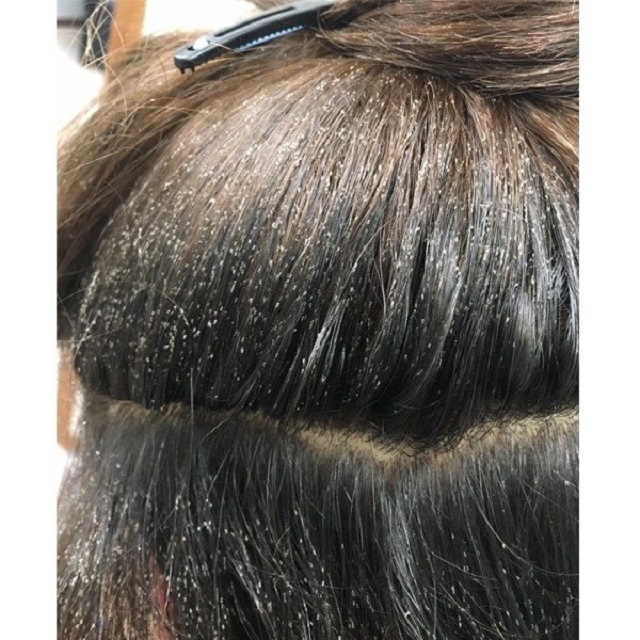
1. Itching:
Lice and their eggs can cause intense itching, especially around the scalp, ears, and neck. An allergic reaction to the saliva of the lice causes this.
2. Redness and irritation:
Repeated scratching can lead to redness and irritation of the scalp and surrounding areas.
3. Small red bumps:
Some people may develop small, red spots on the scalp, neck, or shoulders due to the lice bites.
4. Visible lice eggs:
As previously mentioned, lice eggs are visible to the naked eye and can often be found on or near the hair shaft close to the scalp.
5. Adult lice:
Although lice eggs are a strong indicator of an infestation, adult lice can also be seen crawling on the scalp or hair.
It’s important to note that lice infestations can be treated with proper medication and hygiene practices. If you suspect that you or someone you know has lice eggs or an infestation, it’s best to seek the advice of a healthcare professional or a licensed lice treatment specialist.
Causes Of Lice Eggs
While it is essential to understand the signs and symptoms of lice eggs, it is equally important to understand the causes of their presence. These are some important causes.
Direct Contact:
Direct contact with a person is the most normal way to get lice and lice eggs. It can happen through one-on-one connections, such as hugging, sharing a bed, or playing sports together.
Sharing Personal Items:
Lice can also spread by sharing personal items such as combs, brushes, hats, scarves, and towels with an infected person. The lice or lice eggs can survive on these items for up to 48 hours.
School and Daycare Settings:
Schools and daycare centres are familiar places where lice can be spread. Children are more likely to have close contact with each other and may share personal items such as hats or headphones.
Lack of Personal Hygiene:
While lice do not discriminate based on cleanliness, poor personal hygiene can increase the risk of lice infestation. Lice are attracted to clean hair because it is easier for them to move around.
Overcrowded Living Conditions:
Overcrowding in living spaces can also increase the risk of lice infestation. When people live in close quarters, lice can spread quickly from one person to another.
Climate and Seasonal Factors:
Certain weather and seasonal factors can also contribute to the spread of lice. Lice infestations are more common in warmer months, as lice thrive in humid conditions.
Pets:
Although rare, pets can also carry lice and pass them on to humans. If you have pets, keeping them clean and free of lice is essential to avoid any potential infestation.
Treating Lice Eggs On Your Own:
Treating lice eggs alone can be challenging, but it is possible with the right tools and techniques. Here are some steps you can take to get rid of lice eggs:
Use a specialized lice comb:
A fine-toothed comb designed for lice removal is essential for removing lice eggs. Comb through the wet hair section by section, starting at the scalp and moving down to the ends of the hair.
Apply a treatment:
Various over-the-counter and prescription medicines are available for lice removal. Follow the instructions carefully and cover the entire scalp and hair.
Repeat the process:
Even if you successfully remove all lice eggs and adult lice, it’s essential to repeat the treatment process in 7 to 10 days to ensure that any newly hatched lice are removed.
Clean personal items:
To prevent re-infestation, it’s essential to clean all personal things that may have come into contact with the infected person’s hair or scalp. It includes combs, brushes, hats, scarves, and bedding.
Vacuum:
Vacuuming floors, furniture, and car seats can help remove any lice or eggs that may have fallen off the hair.
Inform close contacts:
Make sure to inform close contacts, such as family members or classmates, so they can also be checked and treated if necessary.
It’s important to note that treating lice eggs can be time-consuming and may require multiple treatments. If you’re struggling to get rid of lice eggs on your own, it’s recommended to seek help from a healthcare professional or lice removal service.
How To Know If You Have Lice Or Dandruff
Are you experiencing an itchy scalp lately? It could be lice or Dandruff. But how can you tell the difference between Lice eggs vs Dandruff? Rest assured, we are here to assist you in finding a solution! Lice and Dandruff are two common conditions that can affect the scalp and cause similar symptoms, such as itching and flaking.
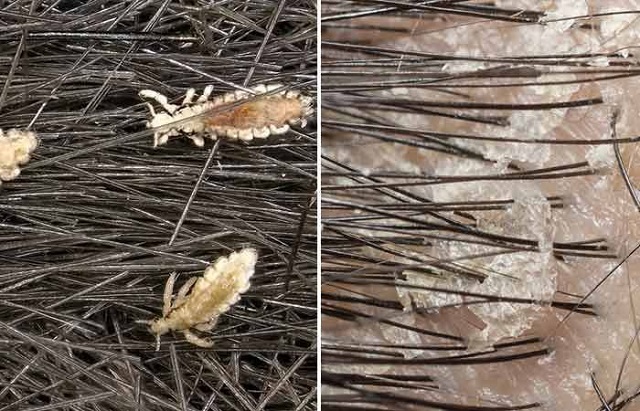
However, some critical differences between the two can help you distinguish between them. Here are some ways to know if you have lice or Dandruff:
1. Appearance: Dandruff appears as white flakes, while lice are small, brown/black bugs or white/yellowish eggs (nits) attached to the hair shaft.
2. Location: Dandruff is usually found all over the scalp, while lice congregate behind the ears and at the nape of the neck.
3. Transmission: Dandruff is not contagious, while lice are highly contagious and can be easily transmitted from person to person.
4. Treatment: Dandruff can be treated with over-the-counter shampoos, while lice require prescription medication from a doctor or pharmacist.
Remember, both conditions are treatable, and you can get rid of them with proper care.
How To Prevent Dandruff And Lice Eggs From Recurring?
Preventing Dandruff and lice from recurring requires regular care and attention to your scalp and hair. Here are some tips to help prevent dandruff and lice eggs from coming back:
1. Keep your scalp clean:
Hello there, fellow travel enthusiasts! Are you constantly seeking out your One of the best ways to prevent dandruff and lice eggs is to keep your scalp clean? Especially wash your hair regularly with a gentle shampoo free from harsh chemicals and irritants. Ensure to rinse your hair with warm water completely.
2. Use a lice comb:
If you’ve had lice before, it’s essential to use a lice comb regularly to remove any nits or eggs that may have been missed during treatment. It will help to prevent a re-infestation.
3. Avoid sharing personal items:
Lice can be easily transmitted through personal items such as combs, brushes, and hats. To minimize the risk of getting lice, refrain from sharing these items with others.
4. Manage stress:
Stress can significantly trigger Dandruff and other scalp conditions. Take time to relax and manage your stress levels to prevent flare-ups.
5. Use natural remedies:
Many natural remedies can help to prevent Dandruff and lice. Tea tree oil, for example, has anti-inflammatory and antifungal properties that can help to soothe an itchy scalp and prevent Dandruff.
Following these tips can help prevent dandruff and lice eggs from recurring and keep your scalp and hair healthy and clean.
When To Consult A Doctor?
Should you see a doctor for lice eggs or Dandruff? Well, it depends on a few things. If you need to check if you have lice or Dandruff, use a fine-toothed comb to check for lice eggs. If you find them, it’s best to see a doctor for proper treatment.
However, over-the-counter treatments should do the trick if you’re confident that you have Dandruff instead. That said, if your symptoms persist or worsen, it’s always a good idea to consult a doctor. In conclusion, whether you’re dealing with lice eggs or Dandruff, it’s crucial to take action and seek medical advice if necessary.
Therefore, it is crucial to identify the difference before treating it. It is also advisable to consult a healthcare professional for proper diagnosis and treatment.
Conclusion:
In the end, distinguishing between lice eggs vs Dandruff can be a real challenge. But fear not, my friend! By taking a closer look at those pesky flakes’ texture, colour, and location, you can better determine which one you’re dealing with. It’s crucial to take action against lice as soon as possible to prevent further spreading, while Dandruff can often be managed with medicated shampoos.
So, no need to worry if you’re facing either of these issues, Lice eggs vs Dandruff – take the appropriate measures to address them, and you’ll be back on track to a healthy scalp and luscious locks. Especially, a healthy scalp leads to healthy hair! All in all, this blog post is a valuable resource for anyone in need of guidance. For more articles click here 21 Hashtags.
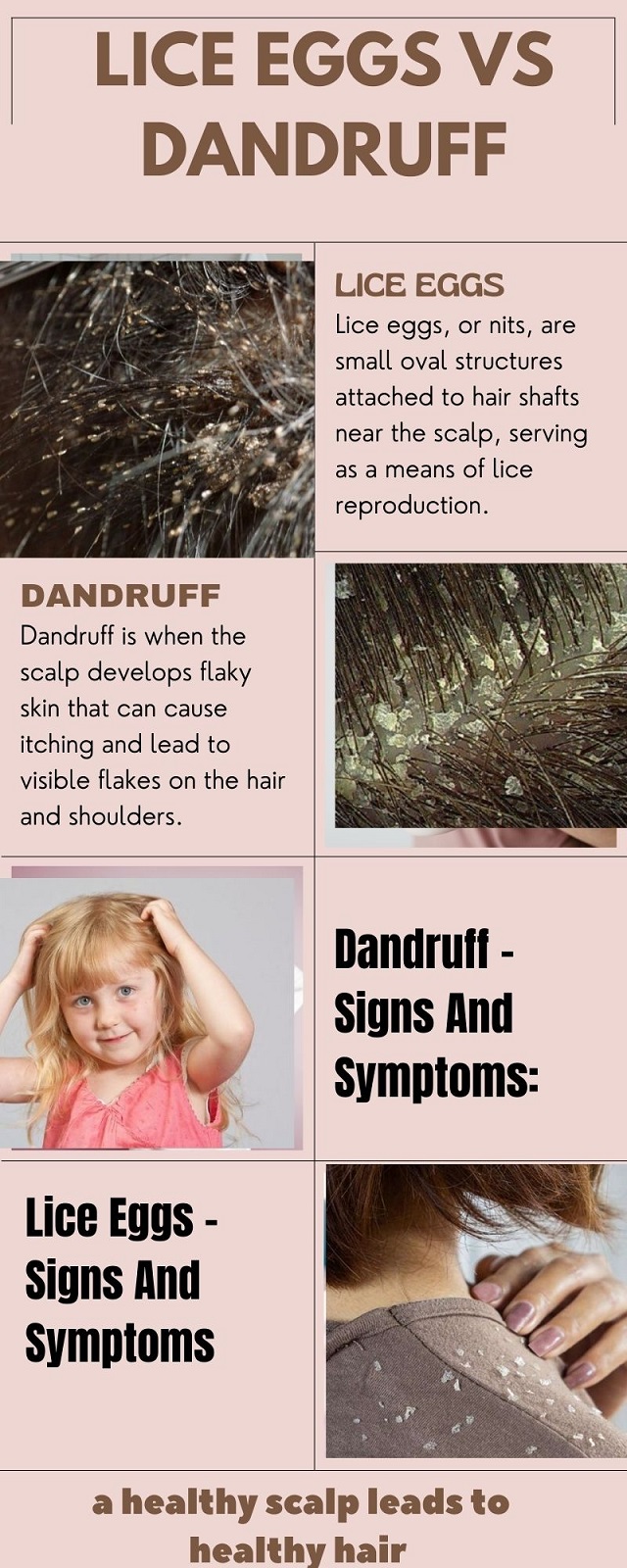
1 comment
Good tips